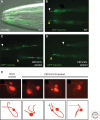Glial development and function in the nervous system of Caenorhabditis elegans
- PMID: 25573712
- PMCID: PMC4382739
- DOI: 10.1101/cshperspect.a020578
Glial development and function in the nervous system of Caenorhabditis elegans
Abstract
The nematode, Caenorhabditis elegans, has served as a fruitful setting for understanding conserved biological processes. The past decade has seen the rise of this model organism as an important tool for uncovering the mysteries of the glial cell, which partners with neurons to generate a functioning nervous system in all animals. C. elegans affords unparalleled single-cell resolution in vivo in examining glia-neuron interactions, and similarities between C. elegans and vertebrate glia suggest that lessons learned from this nematode are likely to have general implications. Here, I summarize what has been gleaned over the past decade since C. elegans glia research became a concerted area of focus. Studies have revealed that glia are essential elements of a functioning C. elegans nervous system and play key roles in its development. Importantly, glial influence on neuronal function appears to be dynamic. Key questions for the field to address in the near- and long-term have emerged, and these are discussed within.
Copyright © 2015 Cold Spring Harbor Laboratory Press; all rights reserved.
Figures




Similar articles
-
The glia of Caenorhabditis elegans.Glia. 2011 Sep;59(9):1253-63. doi: 10.1002/glia.21084. Epub 2010 Nov 2. Glia. 2011. PMID: 21732423 Free PMC article. Review.
-
Glia actively sculpt sensory neurons by controlled phagocytosis to tune animal behavior.Elife. 2021 Mar 24;10:e63532. doi: 10.7554/eLife.63532. Elife. 2021. PMID: 33759761 Free PMC article.
-
Glia-neuron interactions in the nervous system of Caenorhabditis elegans.Curr Opin Neurobiol. 2006 Oct;16(5):522-8. doi: 10.1016/j.conb.2006.08.001. Epub 2006 Aug 28. Curr Opin Neurobiol. 2006. PMID: 16935487 Review.
-
Glia-Neuron Interactions in Caenorhabditis elegans.Annu Rev Neurosci. 2019 Jul 8;42:149-168. doi: 10.1146/annurev-neuro-070918-050314. Epub 2019 Mar 18. Annu Rev Neurosci. 2019. PMID: 30883261 Review.
-
Glia Development and Function in the Nematode Caenorhabditis elegans.Cold Spring Harb Perspect Biol. 2024 Dec 2;16(12):a041346. doi: 10.1101/cshperspect.a041346. Cold Spring Harb Perspect Biol. 2024. PMID: 38565269 Free PMC article. Review.
Cited by
-
Robo functions as an attractive cue for glial migration through SYG-1/Neph.Elife. 2020 Nov 19;9:e57921. doi: 10.7554/eLife.57921. Elife. 2020. PMID: 33211005 Free PMC article.
-
Diversity of developing peripheral glia revealed by single-cell RNA sequencing.Dev Cell. 2021 Sep 13;56(17):2516-2535.e8. doi: 10.1016/j.devcel.2021.08.005. Epub 2021 Aug 31. Dev Cell. 2021. PMID: 34469751 Free PMC article.
-
Schwann cell-secreted PGE2 promotes sensory neuron excitability during development.Cell. 2024 Aug 22;187(17):4690-4712.e30. doi: 10.1016/j.cell.2024.07.033. Epub 2024 Aug 13. Cell. 2024. PMID: 39142281
-
Coordinated neuron-glia regeneration through Notch signaling in planarians.PLoS Genet. 2025 Jan 27;21(1):e1011577. doi: 10.1371/journal.pgen.1011577. eCollection 2025 Jan. PLoS Genet. 2025. PMID: 39869602 Free PMC article.
-
Regulation of axon pathfinding by astroglia across genetic model organisms.Front Cell Neurosci. 2023 Oct 24;17:1241957. doi: 10.3389/fncel.2023.1241957. eCollection 2023. Front Cell Neurosci. 2023. PMID: 37941606 Free PMC article. Review.
References
-
- Albert PS, Riddle DL 1983. Developmental alterations in sensory neuroanatomy of the Caenorhabditis elegans dauer larva. J Comp Neurol 219: 461–481. - PubMed
-
- Albert PS, Brown SJ, Riddle DL 1981. Sensory control of dauer larva formation in Caenorhabditis elegans. J Comp Neurol 198: 435–451. - PubMed
-
- Allen NJ 2013. Role of glia in developmental synapse formation. Curr Opin Neurobiol 23: 1027–1033. - PubMed
Publication types
MeSH terms
Grants and funding
LinkOut - more resources
Full Text Sources
Other Literature Sources
Miscellaneous
